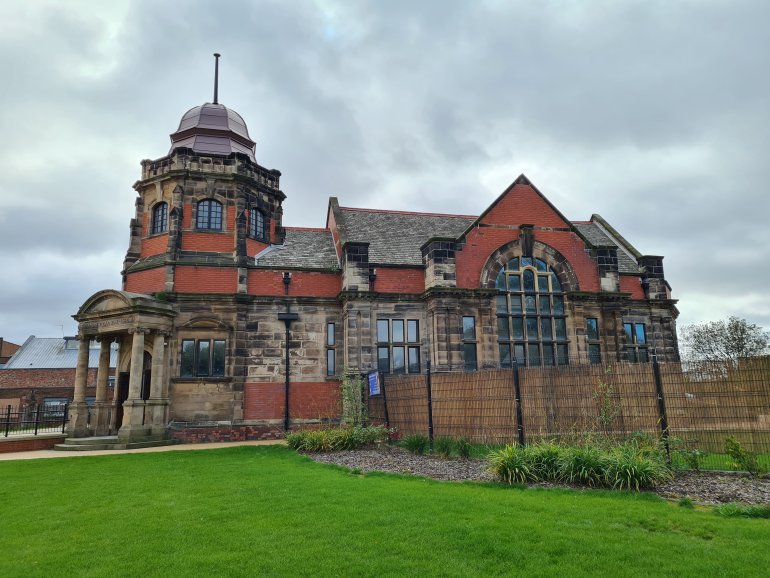From library to learning

Arcadis’ Lenders, Investors and Insurers (LII) team's heritage professionals were collaborators in a highly-commended project that restored and conserved the Grade II listed Old Library in Liverpool into a new childcare nursery and community space.
At a time when the Covid-19 pandemic had caused massive market disruption as well as uncertainty for the construction industry, leading global consultancy Arcadis defied expectations and saw unprecedented growth.
Over a difficult two-year period, LII’s team of consultants, who work specifically with institutional real-estate lenders, investors and insurers, expanded its core service lines to include some significant additions.
The team grew its due diligence, building surveying and monitoring services to include an environmental, sustainability and governance (ESG) consultancy, fire and façade consultancy, and dedicated technical asset management services. Their expertise was recognised with an award for ‘outstanding’ large surveying team at the RICS 2022 awards.
Developing the business’ ESG consultancy has been crucial to transforming its sector, as its submission to the awards notes.
"We are committed to putting a cross-section of LII colleagues through various ESG training to ensure that sustainability is upheld and enforced by all departments throughout our core propositions and services. This ensures that whether we are assisting with an acquisition, asset management or divestment, everything we do is rooted in sustainability."
As Hannah Grover, an Account Leader within LII, explains, Arcadis also has a dedicated crisis management team, which was instrumental in guiding the business throughout the pandemic, enabling the LII team to remain fully operational and to work in a very agile way, so that project delivery was smooth and largely unaffected.
As a result, in 2021 the team of more than 120 real estate specialists, including 45 chartered surveyors, provided technical competence on a diverse range of real-estate projects in the UK and overseas, worth more than £45bn.
Old Library, Liverpool
In the same year LII’s heritage professionals played a pivotal technical advisory role in the restoration and refurbishment of an early 20th century library building in Liverpool.
Owned by Liverpool City Council, the Old Library on Green Lane in Tuebrook had originally been a gift to the local community from philanthropist Andrew Carnegie to ensure that disadvantaged people in this deprived area of the city could have access to social and educational opportunities, including resources to read.
Designed by architect Thomas Shelmerdine and completed in 1904, the library provided this service for around 100 years before it fell into disrepair and was forced to shut in the late 2000s following a health and safety incident. Over the next 13 years, the Grade II listed building’s condition deteriorated rapidly and ultimately became derelict.
The building’s reconstruction incorporated a child care nursery, social enterprise café and multi-functional venue for future generations to enjoy, creating a safe working environment and conserving the building’s listed status.
"One of the biggest challenges was that all of the lead and a lot of the slate and metalwork had been stolen from the building and water had poured in," explains Nigel Green, an associate and a conservation-accredited chartered building surveyor who heads up the LII heritage team.
As a result of the water ingress, the building’s original timber structure had been badly damaged and dry rot was widespread. Despite the fact that Liverpool City Council had undertaken some repairs to mitigate the damage, it was clear that major internal and external refurbishment of a building that had been left empty and unheated for such a prolonged period was required.
The cost and programme certainty of the proposed project was critical to its delivery and Arcadis was instrumental in identifying what essential work was needed, including any unforeseen defects, as well as enabling the costing to be determined at an early stage.
"As the heritage consultant, we gave advice on the condition of the building’s structure, the specification of what needed to be done and how to repair it and then the technical advice once we were onsite," Nigel says.
"Funding constraints at the outset restricted an in-depth examination of the timber decay so we prepared a specification based on what we could see and our experience of similar building types, anticipated defects and forms of construction. The defects uncovered with the timber were extensive and in some cases unexpected."
Working with client OMI Architects, together with Liverpool City Council and Lister Steps, the childcare nursery operator, Green explains that partial funding for the project’s build came from the Heritage Lottery Fund.
He adds that the design for the library’s sensitive reconstruction, as well as ensuring the space was fit for the purpose of its intended future use, started about six years before building work began onsite.
Actual site work commenced two weeks before the first Covid lockdown and, despite some unavoidable disruption, the work was completed in 52 weeks.
"It was a very old fashioned, late Victorian-style library with separate reading rooms with high-vaulted ceilings," Nigel explains.
"But by subdividing the building into two distinct sections so that the children’s day nursery was in one reading room and the event space, including the social enterprise café, was in the other reading room, we were able to maximise the available space and so ensure a safe environment for the children with a distinct and separate events space for the local community."
Collaborative approach
A large part of the project’s success and one of the reasons it won the Heritage Project of the Year category for the Northwest Region at the RICS Awards 2022 was the collaborative team approach that was taken.
"We were either on a Teams call on a daily basis or onsite examining the structure. The main contractor HH Smith & Sons worked with us to ensure we were fully appraised of the defects within the concealed fabric," he says.
"HH Smith & Sons had a good understanding of the required conservation approach and with their support and recommendations, our method of working really helped to overcome the challenges."
To ensure that the building’s listed status was preserved throughout the sensitive reconstruction work, it was critical that the right materials were sourced.
"With all of our historic building projects, we use a conservation approach," Green explains.
"We try to use materials that were either sourced from the same location or a very similar material. While investigating how the original building was built, we discovered the original windows had been supplied by a company called REA Windows who still trade within walking distance of the Old Library.
"We specified REA Windows as the manufacturer and installer of the new windows and used double glazing that closely resembled the design and appearance of the original. The windows were one of the biggest contributors to energy saving in the repaired building."
The project team also followed the Forestry Commission’s recommendation to use sustainable timber and modern treated wood was sourced to replace any defective timber. They also need to replace sections of the stone and brickwork that had been damaged beyond repair or were missing.
One of the conditions of the Heritage Lottery funding was a requirement for HH Smith & Sons to employ apprentices for the restoration work and to provide a bursary grant.
During the build, two bursary apprenticeships were provided and on a successful completion, one of the apprentices obtained a full-time post with the subcontractor he was assigned to and the other was retained by the main contractor through to the completion of the works.
Additionally, Arcadis aided educational groups and Liverpool Architectural Society on special interest visits and held technical events focusing on conservation of stonework and heritage skills.
"This felt particularly important, when at this time, a heritage skills shortage threatens our built heritage," says Green.
Commenting on the project, the RICS’ national heritage project judge noted: "Through extensive research combined with a very high standard of conservation, this much-loved Grade II listed building has been systematically restored and sensitively adapted to reflect its historical past while ensuring its future for the local community."






